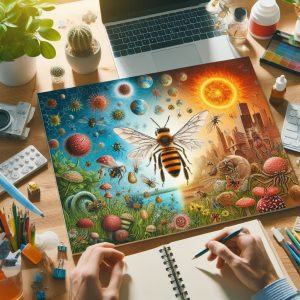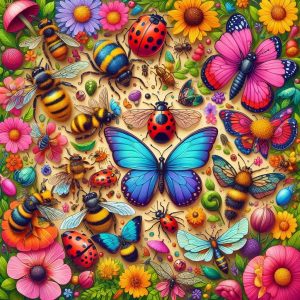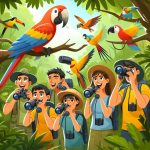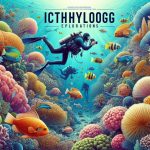Entomology is the branch of zoology that focuses on the study of insects. This field explores the anatomy, behavior, ecology, and classification of insects. Entomologists play a crucial role in understanding the diverse forms and functions of insects, their roles in ecosystems, and their interactions with humans.
- Medical Entomology: Studies insects that impact human health, such as mosquitoes that transmit diseases like malaria and dengue.
- Agricultural Entomology: Focuses on insects that affect crops, aiming to develop pest control methods.
- Ecological Roll: Examines the roles of insects in ecosystems, including pollination and decomposition.
- Agriculture: Developing integrated pest management strategies to reduce crop damage and increase yields.
- Medicine: Controlling insect vectors of diseases such as malaria, dengue, and Zika virus.
- Forensics: Using insects to estimate the time of death in forensic investigations.
- Environmental Science: Monitoring insect populations as indicators of environmental health and biodiversity.Scientific Research: Insects are model organisms in genetics, physiology, and evolutionary biology, providing insights into fundamental biological processes
Major Areas of Entomological Research
Entomologists focus on various research areas, including:
- Taxonomy and Systematics: The classification and naming of insects, understanding their evolutionary relationships.
- Behavioral Entomology: Studying insect behavior, including mating, foraging, and communication.
- Ecology: Investigating the roles of insects in ecosystems, their interactions with other organisms and their environment.
- Medical and Veterinary Entomology: Focusing on insects that affect human and animal health.
- Agricultural Entomology: Studying insects that impact crops and developing pest management strategies.
Table: Key Areas of Entomology
| Area | Focus | Importance |
|---|---|---|
| Taxonomy and Systematics | Classification and naming of insects | Understanding evolutionary relationships |
| Behavioral Entomology | Insect behavior studies | Insights into mating, foraging, communication |
| Ecology | Roles in ecosystems | Interactions with organisms and environment |
| Medical and Veterinary Entomology | Impact on human and animal health | Disease prevention and control |
| Agricultural Entomology | Impact on crops | Pest management strategies |
Insect Diversity
Insects exhibit a remarkable diversity in form, function, and habitat. They are found in nearly every environment on Earth, from the deepest oceans to the highest mountains. This diversity is a result of their long evolutionary history and ability to adapt to various ecological niches.
- Insect Orders: There are approximately 30 different orders of insects, each with unique characteristics. Some of the most well-known orders include Lepidoptera (butterflies and moths), Coleoptera (beetles), Diptera (flies), Hymenoptera (bees, wasps, and ants), and Orthoptera (grasshoppers and crickets).
- Adaptations: Insects have evolved various adaptations that enable them to survive in diverse environments. These adaptations include specialized mouthparts for feeding, wings for flight, and unique reproductive strategies.
- Life Cycles: Insects exhibit a range of life cycle strategies, including complete metamorphosis (egg, larva, pupa, adult) and incomplete metamorphosis (egg, nymph, adult). Understanding these life cycles is essential for studying insect development and behavior.
Insect-Plant Interactions
Insects have complex interactions with plants, which can be beneficial or detrimental to agriculture and ecosystems:
- Pollination: Many insects, such as bees, butterflies, and beetles, are important pollinators of flowering plants. Pollination is critical for plant reproduction and the production of fruits and seeds.
- Herbivory: Some insects feed on plants, causing damage to crops and natural vegetation. Understanding herbivory patterns helps in developing pest management strategies.
- Mutualism: Certain insects form mutualistic relationships with plants. For example, ants protect plants from herbivores in exchange for food or shelter provided by the plant.
Table: Examples of Insect-Plant Interactions
| Interaction | Example | Impact |
|---|---|---|
| Pollination | Bees pollinating flowers | Essential for plant reproduction and fruit production |
| Herbivory | Caterpillars eating leaves | Can cause significant crop damage |
| Mutualism | Ants protecting acacia trees | Provides defense for the plant and food for the ants |
Applications of Entomology
Entomological research has numerous practical applications:
Technological Advances in Entomology
The future of entomology will be shaped by several key technological advancements:
- Genomic Technologies: Advances in genomic sequencing and gene editing technologies such as CRISPR will allow entomologists to study insect genetics in unprecedented detail. This will enable the development of targeted pest control strategies and enhance our understanding of insect evolution and adaptation.
- Remote Sensing and GIS: The use of remote sensing technologies and Geographic Information Systems (GIS) will revolutionize the study of insect distribution and movement patterns. These tools will help in monitoring insect populations, tracking migration, and understanding the impacts of environmental changes on insects.
- Artificial Intelligence: AI and machine learning algorithms will be increasingly used to analyze large datasets in entomology, from genomic data to field observations. These technologies will facilitate predictive modeling and improve decision-making in pest management and conservation efforts.
- Automated Monitoring Systems: Automated traps and sensors will provide real-time data on insect populations, helping researchers and farmers to monitor pest levels and take timely action. These systems will be crucial for integrated pest management (IPM) programs.
Table: Key Technological Advances in Entomology
| Technology | Description | Impact |
|---|---|---|
| Genomic Technologies | Genomic sequencing, CRISPR gene editing | Enhanced genetic understanding, targeted pest control |
| Remote Sensing and GIS | Monitoring insect distribution and movement | Improved population tracking, environmental impact analysis |
| Artificial Intelligence | Data analysis, predictive modeling | Enhanced decision-making in pest management |
| Automated Monitoring Systems | Real-time data collection on insect populations | Timely pest management actions, IPM support |
Sustainable Pest Management
Sustainable pest management will be a critical focus in the future of entomology. Integrated Pest Management (IPM) strategies that combine biological, cultural, mechanical, and chemical methods will be increasingly adopted. Entomologists will work on developing eco-friendly pest control methods, such as using natural predators, parasitoids, and microbial agents to keep pest populations in check.
Table: Integrated Pest Management Strategies
| Strategy | Description | Examples |
|---|---|---|
| Biological Control | Using natural predators and parasitoids | Ladybugs for aphid control, parasitic wasps for caterpillars |
| Cultural Control | Agricultural practices to reduce pest habitat | Crop rotation, intercropping |
| Mechanical Control | Physical methods to remove or kill pests | Traps, barriers, hand-picking |
| Chemical Control | Use of pesticides and insecticides | Organic and synthetic chemicals |
Global Collaboration and Education
The future of entomology will also involve increased global collaboration and education. Researchers, policymakers, and the public must work together to address the challenges posed by insect populations. International partnerships will be essential in sharing knowledge, resources, and strategies to manage pest species and conserve beneficial insects. Educational programs and outreach efforts will be vital in raising awareness about the importance of insects and the need for their conservation.
Future Directions in Entomology
- Genomic Research: Utilizing genetic tools to study insect populations, their evolutionary history, and responses to environmental changes.
- Climate Change Impact: Investigating the effects of climate change on insect habitats and developing conservation strategies to mitigate these impacts.
- Integrative Approaches: Combining field studies with laboratory research and advanced technologies like GIS and remote sensing to gain a comprehensive understanding of insect species.
- Public Engagement: Increasing public awareness and involvement in entomological research and conservation through education and citizen science programs.
Applications of Genomic Research
The applications of genomic research in entomology are vast and diverse. Here are some key areas where genomic technologies are making significant impacts:
- Pest Control: By understanding the genetic basis of insecticide resistance, scientists can develop more effective pest management strategies. For example, researchers can identify specific genes responsible for resistance and design targeted interventions to overcome them.
- Insect-Borne Diseases: Genomic research is crucial in studying vector insects such as mosquitoes and ticks, which transmit diseases like malaria, dengue, and Lyme disease. By sequencing the genomes of these vectors, scientists can identify genetic factors that influence disease transmission and develop targeted control measures.
- Evolutionary Studies: Genomic data allows entomologists to trace the evolutionary history of insects, revealing how they have adapted to different environments over time. This information is essential for understanding biodiversity and the impact of environmental changes on insect populations.
- Conservation Genetics: For endangered insect species, genomic research provides insights into their genetic diversity and population structure. This information is vital for developing conservation strategies to protect and restore these species.
Table: Key Applications of Genomic Research in Entomology
| Application | Description | Impact |
|---|---|---|
| Pest Control | Identifying genes responsible for insecticide resistance | Enhanced pest management strategies |
| Insect-Borne Diseases | Studying vectors like mosquitoes and ticks | Improved disease control measures |
| Evolutionary Studies | Tracing evolutionary history and adaptations | Understanding biodiversity and environmental impacts |
| Conservation Genetics | Assessing genetic diversity of endangered species | Development of effective conservation strategies |
Future Directions in Genomic Research
The future of genomic research in entomology holds great promise. Here are some exciting directions for future studies:
- Metagenomics: This approach involves analyzing the collective genomes of all organisms in a particular environment, such as the gut microbiome of insects. Metagenomic studies can reveal complex interactions between insects and their microbial communities, with implications for pest control and health.
- Functional Genomics: Functional genomics aims to understand the roles of genes and their interactions. By using techniques such as RNA interference (RNAi) and CRISPR, scientists can study gene function and regulation in insects, leading to new insights into their biology and behavior.
- Population Genomics: This field focuses on the genetic variation within and between insect populations. Population genomics can inform conservation efforts by identifying genetic factors that influence population viability and resilience to environmental changes.
- Bioinformatics: As genomic datasets become increasingly large and complex, bioinformatics tools will be essential for data analysis and interpretation. Advances in bioinformatics will enable researchers to uncover new patterns and relationships in genomic data, driving further discoveries in entomology.

Effect of Climate Change on Insect Populations: –
Climate change affects insects in various ways, including shifts in geographic ranges, changes in population dynamics, and alterations in seasonal behaviors. Here are some key effects:
- Range Shifts: As temperatures rise, many insect species are moving towards higher altitudes and latitudes in search of suitable habitats. This shift can lead to the colonization of new areas, potentially affecting local ecosystems and agriculture.
- Phenological Changes: Climate change is causing shifts in the timing of life cycle events, such as breeding, migration, and hibernation. These phenological changes can disrupt the synchronization between insects and their food sources, predators, and mutualistic partners.
- Population Dynamics: Changes in climate can lead to fluctuations in insect population sizes. Warmer temperatures may increase the survival and reproduction rates of some species, leading to population explosions, while others may face increased mortality.
- Emergence of Pests: Climate change can create favorable conditions for the spread of pest species. For example, warmer winters may allow more pests to survive and thrive, posing a significant threat to crops and natural vegetation.
Table: Key Effects of Climate Change on Insects
| Effect | Description | Impact |
|---|---|---|
| Range Shifts | Movement towards higher altitudes and latitudes | Colonization of new areas, ecosystem disruption |
| Phenological Changes | Alteration in timing of life cycle events | Disruption of ecological interactions |
| Population Dynamics | Fluctuations in population sizes | Population explosions or declines |
| Emergence of Pests | Favorable conditions for pest spread | Increased threat to agriculture and vegetation |
Adaptive Strategies and Research Focus
To address the impacts of climate change on insects, researchers are focusing on several adaptive strategies and areas of study:
- Climate-Resilient Crops: Developing crop varieties that are more resilient to pest attacks and changing environmental conditions. This involves understanding the interactions between crops and insect pests under different climate scenarios.
- Conservation Planning: Implementing conservation strategies that consider the future impacts of climate change on insect populations. This includes creating protected areas and corridors that allow for range shifts.
- Long-Term Monitoring: Establishing long-term monitoring programs to track changes in insect populations and distributions. These programs provide critical data for modeling future trends and informing conservation efforts.
- Integrated Pest Management (IPM): Enhancing IPM strategies to be more adaptive and resilient to climate change. This involves using a combination of biological, cultural, mechanical, and chemical controls tailored to changing pest dynamics.
Table: Adaptive Strategies in Entomology
| Strategy | Description | Impact |
|---|---|---|
| Climate-Resilient Crops | Developing crops resistant to pests and environmental changes | Enhanced agricultural productivity |
| Conservation Planning | Creating protected areas and migration corridors | Support for range shifts and biodiversity conservation |
| Long-Term Monitoring | Tracking insect population and distribution changes | Informed conservation and management decisions |
| Integrated Pest Management (IPM) | Adapting IPM strategies to changing pest dynamics | Sustainable pest control |
Future Research Directions
Looking ahead, future research in entomology will need to focus on:
- Predictive Modeling: Developing predictive models to forecast the impacts of climate change on insect populations and their interactions with ecosystems. These models will help in planning and implementing adaptive strategies.
- Genetic Adaptation: Studying how insects genetically adapt to changing climates. This research will provide insights into the evolutionary responses of insects and help in developing resilient pest management strategies.
- Ecosystem Interactions: Investigating the broader ecological impacts of climate change on insect-plant, insect-animal, and insect-microbe interactions. Understanding these interactions is crucial for maintaining ecosystem health and function.
Interdisciplinary Collaboration
Integrative approaches involve collaboration across different scientific disciplines, combining expertise from fields such as ecology, genetics, climatology, and social sciences. By working together, researchers can develop a more comprehensive understanding of the impacts of climate change on insects and devise holistic solutions.
- Ecology and Genetics: Combining ecological studies with genetic research helps in understanding how insect populations adapt to changing environments. This integrative approach provides insights into the resilience and adaptability of different species.
- Climatology and Entomology: Collaborating with climatologists enables entomologists to incorporate climate data into their research, improving predictions about how insect populations will respond to future climate scenarios.
- Social Sciences: Engaging with social scientists helps in understanding human behaviors and societal impacts related to insect populations. This knowledge is essential for developing effective public policies and conservation strategies.
Table: Interdisciplinary Collaboration in Entomology
| Discipline | Contribution | Impact |
|---|---|---|
| Ecology | Understanding insect population dynamics | Insights into resilience and adaptability |
| Genetics | Studying genetic adaptation mechanisms | Enhanced pest management strategies |
| Climatology | Incorporating climate data into research | Improved predictions and strategies |
| Social Sciences | Analyzing human behaviors and impacts | Effective public policies and conservation |
Public Engagement and Education
Public engagement is critical for the success of entomological research and conservation efforts. Educating the public about the importance of insects, the challenges they face, and the ways individuals can contribute to their conservation fosters a sense of responsibility and encourages proactive participation.
- Citizen Science: Involving the public in scientific research through citizen science projects. This approach not only helps gather valuable data but also raises awareness and interest in entomology among non-scientists.
- Educational Programs: Developing educational programs for schools, communities, and online platforms to teach people about insects and their ecological roles. These programs can inspire future entomologists and conservationists.
- Public Policy Advocacy: Engaging with policymakers to advocate for regulations and policies that protect insect habitats and promote sustainable practices. Public support can influence policy decisions and drive legislative changes.
- Media Outreach: Utilizing various media channels to disseminate information about entomology and conservation efforts. Articles, documentaries, social media campaigns, and public talks can reach a wide audience and generate support for entomological research.
Table: Public Engagement Strategies
| Strategy | Description | Impact |
|---|---|---|
| Citizen Science | Involving the public in scientific research | Data collection and public awareness |
| Educational Programs | Teaching about insects and their roles | Inspiration and future conservationists |
| Public Policy Advocacy | Advocating for supportive regulations | Influence on policy decisions |
| Media Outreach | Using media to share information | Widespread support and awareness |
FAQs About Entomology
What is entomology?
Entomology is the scientific study of insects, encompassing their classification, life cycles, behavior, ecology, and their interactions with humans, plants, and other animals.
What do entomologists do?
Entomologists conduct research to understand insect biology and ecology. They may work in agriculture, forestry, public health, environmental conservation, and academic research, studying insect behavior, pest management, pollination, and the roles insects play in ecosystems.
Why is the study of insects important?
Insects are vital to ecosystems due to their roles in pollination, decomposition, and serving as a food source for other animals. Studying insects helps in pest control, disease prevention, and understanding biodiversity and ecosystem health.
How are insects classified?
Insects are classified into various orders based on their characteristics. Common orders include Coleoptera (beetles), Lepidoptera (butterflies and moths), Diptera (flies), Hymenoptera (bees, wasps, and ants), and Orthoptera (grasshoppers and crickets).
What are some key areas of study within entomology?
Key areas of study within entomology include insect physiology, taxonomy, ecology, behavior, medical and veterinary entomology, forensic entomology, and integrated pest management. Each area offers insights into different aspects of insect life and their impact on the environment and human activities.
Disclaimer
The information provided in this section is for educational purposes only. While efforts have been made to ensure the accuracy of the content, it should not be used as a substitute for professional advice or scientific research. Readers are encouraged to consult authoritative sources and experts in the field of entomology for more detailed information.
Caution
When studying or handling insects, it is important to follow ethical guidelines and safety protocols. Insect research should be conducted responsibly, with consideration for the welfare and conservation of species. Always seek guidance from experienced professionals and adhere to local regulations and international standards.






